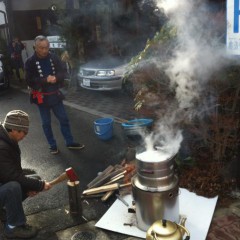日本のお正月習慣、餅つき。
私の出会いは大学を卒業してから上田市で生活した冬。お正月で大手スーパーで買い物をしたら、入口で人が集まって盛り上がっていた。あっ、噂の餅つきだと分かった。勿論、私も参加してみた。まあ、単純な習慣だなと思った。
このお正月亀清旅館の玄関にある昔からの臼を使って、何十年ぶりに餅つきを挑戦する様になった。従って、私は餅つきの準備の段階から始めて経験した。杵(ハンマーじゃなかったんだ)の手配、臼の準備(水を前持ってかけといて、吸い込ませる)、蒔きを炊く釜の購入、餅のトッピングの準備、そして打つ前の餅米を蒸す。意外に奥深い。今回は色んな先輩に助けて頂いて、準備は無事に出来た。
もう、餅つきのは単純じゃないって事、よく分かりました。
Mochi (sticky rice) -Tsuki (pounding) is an age-old New Years tradition here in Japan. My first experience was back when I lived in Ueda City after graduating college. During my first winter here, I went to a shopping center around New Years. At the entrance, a bunch of people were gathered and were making an exciting commotion. As I went to check it out, I saw the Mochi-pounding in action, and realized that was the legendary Mochi-Tsuki.
Of course, I tried my hand with the hammer and helped pound. My first impression was the whole thing seemed a bit simple.
For this New Years, we at Kamesei decided to make use of the antique mochi-pounding mortar, and do a Mochi-Tsuki event for our guests. Hence, for the first time, I experienced the process from the beginning stages. Procuring the 'kine' hammers, prepping the 'usu' mortar by soaking its bowl with water, buying the wood-burning pot set, using it to pre-steam the Mochi rice. Fortunately a couple of guardian angels from our neighborhood came and coached me through the process. Our Mochi prep was a success!
I no longer consider Mochi-making to be 'simple'!




